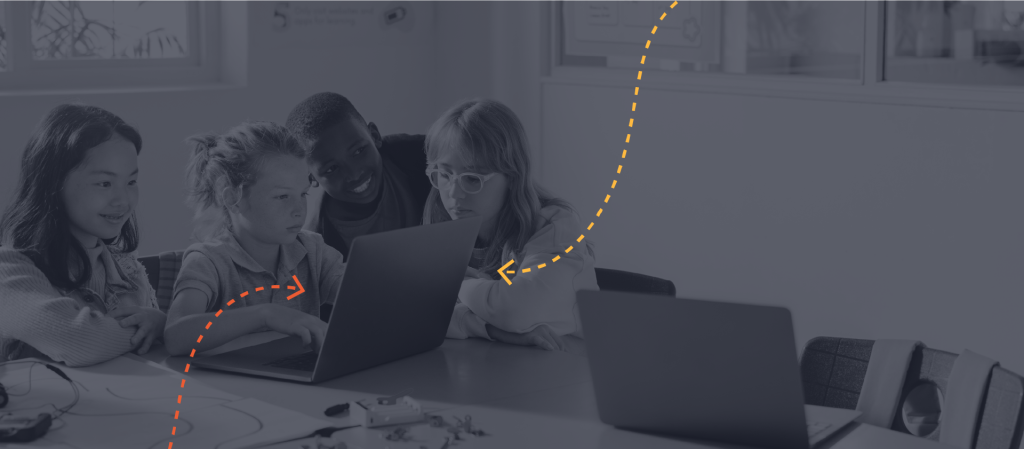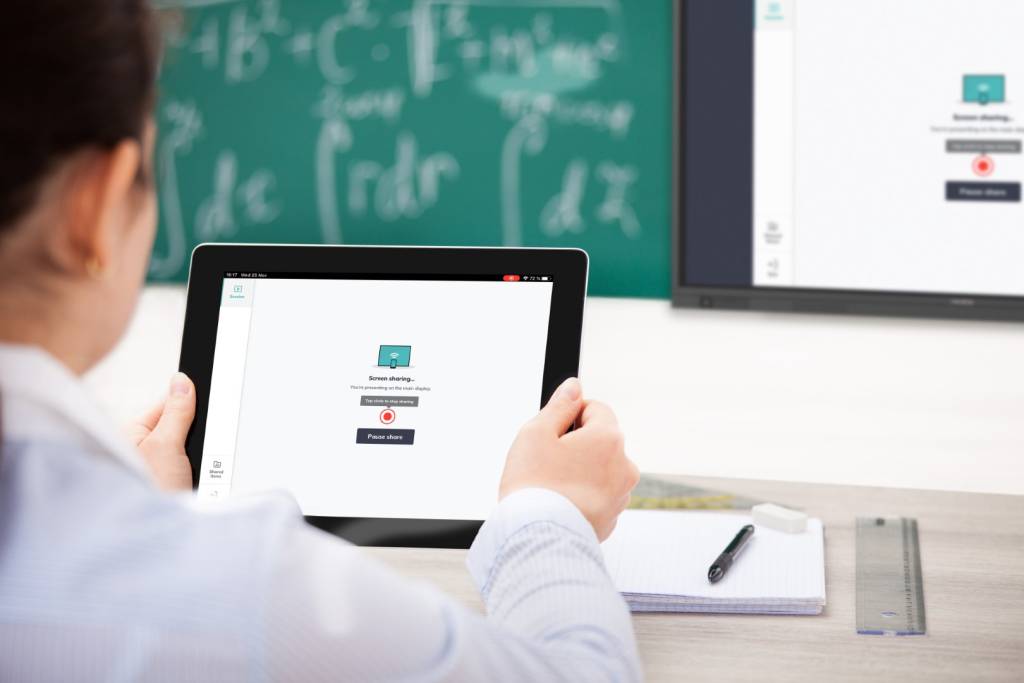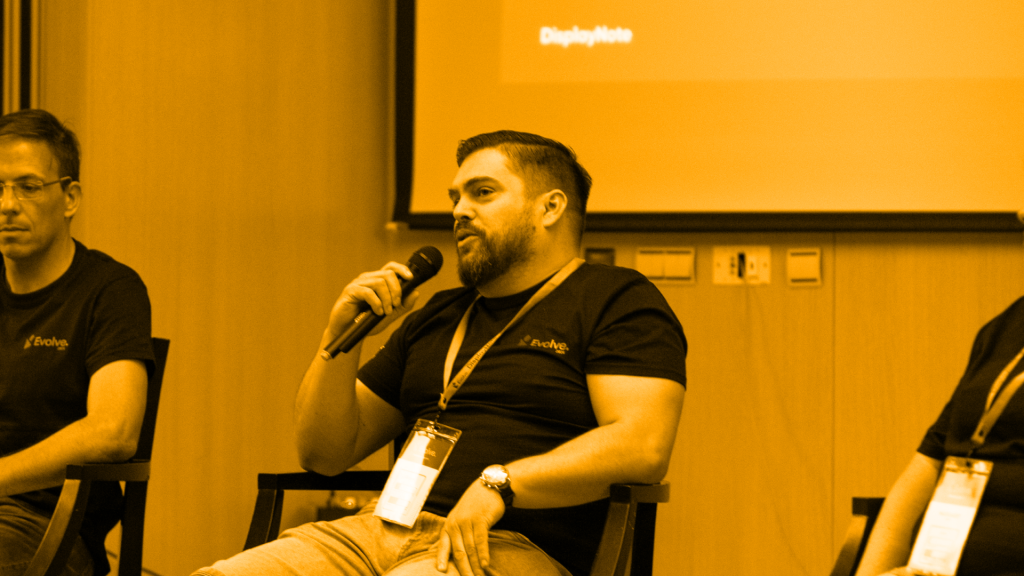
A Teacher’s Handbook on Screen Sharing, Mirroring, and Casting
Let’s set the scene…It’s Monday morning. You’ve prepared a presentation and a few YouTube videos to share with your class.
The room you’re in has a large display at the front that you’d like to share to. You know there’s some type of screen-sharing solution fitted in the room – Ok. No problem. So, do you cast, stream, mirror, or share to the main display? What’s the difference? Is there a difference? It’s all just sharing content from one screen to another screen, right?
Casting, Streaming, Sharing, Mirroring, AirPlay, Miracast, Chromecast…Modern screen sharing technology is expansive and extensive. It’s no surprise that in December 2020 alone, more than 500 new words were added to the Oxford English Dictionary.
We think it’s time to define and debunk the synonymously used terms, answering the burning question – What is screen sharing? Is there a difference between mirroring and casting? And does it even matter?

Screen sharing, mirroring, and casting: an overview
All involve sharing your content to another TV, screen, or monitor from a computer, smartphone, or tablet. However, there are fundamental differences, and these differences lie in how the content is shared with the other device and what you can do with the content.
So, let’s dive in. We’ll start with…
Screen sharing
Screen sharing is when you want to show your exact desktop, laptop, phone, or tablet screen (or an application window of the screen) on displays in other locations. You generally share a window of activity with your audience, for example, a Chrome browser.
When would this be useful?
Screen sharing is useful when you want to share content with other individuals who are not in the same location as you; it’s also great for those joining from different networks. As you can imagine, this is an important feature given the current hybrid climate.
With social restrictions on gatherings still in place in many countries, many schools and businesses have resorted to remote working. screen sharing has become a popular tool during video calls, as it allows you to share your content with the other attendees on the call, meaning they can follow the content on your screen while you talk.

Benefits
- Not restricted by geographic location – you don’t need to be in the same room as your audience to share your screen.
- Real-time collaboration – great for presentations or sessions that require content and a guided discussion of the material
- Privacy – you can choose which window of activity you share with your audience.
Limitations
- Limited accessibility – screen sharing often depends on your audience having the same software as you to support screen sharing.
Screen mirroring

Think of a mirror – your activity will be reflected directly on the device you’re sharing with. You’ll need a display, TV, projector, or monitor that can receive content wirelessly to do this.
When would this be useful?
Screen mirroring is useful for in-person collaboration sessions when you want to show everyone in the room your exact activity or movements on your device. The presenter can display content from a more accessible device (like a laptop or tablet) and present it to a large screen, monitor, or projector for the whole room to see.
Give me an example
You want to demonstrate how to use new statistical software with your class or colleagues. Unlike casting, which only shares the media clip or file, with mirroring, everyone in the room can follow each step on the big screen as you perform them in real-time on your device. As a presenter, this allows you to draw attention to specific points and answer questions with context.
Airplay is an example of mirroring – your device acts as a broadcaster, the screen acts as a receiver. This allows you to mirror your device activity on the larger screen.
Benefits
- Accessible – certain solutions (like Montage) can be accessed from a browser meaning anyone with any device can share their content.
- Flexible – turn any TV/display/projector or monitor into a screen.
- Real-time collaboration – great for presentations or sessions that require content and a guided discussion of the material.
- Full support for all apps – whatever you can perform on your device, you can perform on the shared screen.
- Good usability – uses the applications on your device you’re already familiar with.
Limitations
- Battery and Wi-Fi intensive – the device you’re sharing from will do the heavy lifting here
- Can’t multitask – what you see, everyone sees. With our wireless screen sharing solution, Montage, you can use the DisplayNote app to pause and play with mirroring, keeping you in control of your privacy.
Screencasting
Screencasting allows you to play music, videos, or content from your phone, computer, or tablet onto another device. It’s different from mirroring in that you can no longer see the content on your device as it casts.
You’ll probably be most familiar with Chromecast – a device plugged into the back of a TV or display, picking up the signal from certain apps and allowing you to cast your content. Once your content is casting to the display or TV, you can control it from there.
When would this be useful?
Screencasting is useful when you want to play a video, audio, or media file on a large display, monitor, or TV. For example, you’re instructing a class and want to play a related video clip from YouTube on the screen at the front of the room. It means you can also continue to use your device while something is casting.
Benefits
- High-quality video streaming – great for playing videos on a larger display.
- Multitasking – you can continue to use your personal device while casting.
- Battery and Wi-Fi friendly – casting is less demanding on your device’s battery and Wi-Fi consumption.
Limitations
- Limited support – although there are plenty of devices that support casting, many don’t. Plus, only a few media formats are supported.
- Equipment costs
- Network issues
- Usability – you are limited in what media formats you can share.
- Not interactive – you can’t share your device activity in real-time or add notes/annotations to give context to the material.
In summary…
How is screencasting different from screen mirroring?
1. When casting, you’re not displaying your entire device screen and activity.
This is why you can still use your phone when you’re casting a Youtube video to a TV. When mirroring, you are sharing your real-time device activity.
2. When casting, the content is not played from your device.
The TV, display, or projector you’re casting receives your online content via a digital media player. Screen mirroring involves sending your screen activity to the TV, display, or projector via a cable or wireless connection.
How is screen sharing different from screen mirroring?
They’re basically both the same. Except…
- screen mirroring is used to share content from your device to another device in the same room, irrespective of what device or network you’re using (phone, computer, tablet).
- screen sharing is often used when sharing content remotely (for example, sharing your screen on a video call to other people in a different location). It requires all participants to have the same software or compatible hardware.
Each has benefits and drawbacks. This is due to the different technology that drives each process.
Simplify screen sharing in the classroom with Montage
We incorporated the benefits of both screen sharing and mirroring into our collaboration software, Montage. And as a software-only solution, you don’t need adaptors or cables to share your or your audience’s screen.
Montage is also equipped with smart collaboration tools like Screen Annotation and Grid View (for up to four devices), giving you more flexibility and control over how content is shared.
Explore our screen sharing solutions for education
Want to stay in the loop?
Keep up-to-date with everything DisplayNote – including new releases, job openings, and customer giveaways.
Don’t worry, we’ll not spam you and we’ll never share your email with anyone







